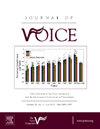听者对巴西母语葡萄牙语中发音障碍的态度的预测因素。
IF 2.5
4区 医学
Q1 AUDIOLOGY & SPEECH-LANGUAGE PATHOLOGY
引用次数: 0
摘要
研究目的验证听者的态度判断是否因发声偏差的存在、严重程度和类型而存在差异,并确定巴西葡萄牙语听者对发音障碍的态度的预测因素:方法:使用 44 名男女受试者的 CAPE-V 句子样本。这些样本呈现了不同严重程度的发声偏差(一般等级 - GG)(健康、轻度、中度和重度)以及不同程度的粗糙度(GR)、呼吸感(GB)和紧张度(GS),由语言治疗师进行感知-听觉判断。这些样本被展示给 152 名男女听者,他们对 12 种态度进行判断,这些态度包含在之前为本研究验证过的语义差异量表中。在此,我们使用了逻辑回归模型:结果:听众的性别与态度判断之间没有关联。与声乐健康的人相比,声乐质量偏差的受试者受到的负面评价更多。我们发现,GG 越高,听者对说话者的负面评价越高。听者对喘气和紧张的声音的负面评价更高。在女声和男声的一般模型中,GB 和 GG 的增加使声音得到正面评价的几率分别降低了 16% 和 20%。对于女声,GB 和 GS 分别使女声获得正面评价的几率降低了 36% 和 19%。GG 使男声获得正面评价的几率降低了 46%,而 GR 则使男声获得正面评价的几率提高了 62%:结论:声音偏差的存在、严重程度和类型与听众的态度之间存在关联。我们在巴西葡萄牙语使用者中建立了一个听者对发音障碍态度的预测模型。一般来说,GG 和 GB 是预测听众负面态度的因素。GB 和 GS 是对女声持负面态度的预测因子。GG 是对男性声音持负面态度的预测因子,而 GR 则增加了正面判断的几率。本文章由计算机程序翻译,如有差异,请以英文原文为准。
Predictive Factors of Listeners’ Attitudes Related to Dysphonic Voices in Native Brazilian Portuguese
Objectives
To verify whether there are differences in the judgments of listeners’ attitudes as a function of the presence, severity, and type of vocal deviation, and to identify the predictive factors of listeners’ attitudes toward dysphonic voices in Brazilian Portuguese speakers.
Methods
A sample of CAPE-V sentences was used from 44 subjects of both genders. The samples presented different severities of vocal deviation (general grade - GG) (healthy, mild, moderate, and severe) and different degrees of roughness (GR), breathiness (GB), and strain (GS), characterized by a perceptual-auditory judgment performed by speech therapists. The samples were presented to 152 listeners of both genders who performed the judgment of 12 attitudes inserted in a semantic differential scale previously validated for this study. Here, we used a Logistic Regression Model.
Results
There was no association between listener's gender and the judgment of attitudes. Subjects with vocal quality deviation were judged more negatively in relation to vocally healthy individuals. We observed that higher the GG, higher the negative judgment of listeners in relation to the speakers. Listeners judged breathy and strained voices as more negative. In the general model for female and male voices, the increase in GB and GG reduced the chance of a voice being evaluated positively by 16 and 20%, respectively. For female voices, GB and GS reduced the chance of a female voice being evaluated positively by 36 and 19%, respectively. GG reduces the chance of a male voice being evaluated positively by 46%, while GR increases the chance of a male voice being judged positively by 62 %.
Conclusions
There is an association between the presence, severity, and type of vocal deviation and listeners’ attitudes. We identified a predictive model of listeners' attitudes related to dysphonic voices among Brazilian Portuguese speakers. In general, GG and GB were predictors of negative attitudes toward listeners. GB and GS were predictors of negative attitudes toward female voices. The GG is a predictor of negative attitudes toward male voices, while the GR increases the chance of positive judgments.
求助全文
通过发布文献求助,成功后即可免费获取论文全文。
去求助
来源期刊

Journal of Voice
医学-耳鼻喉科学
CiteScore
4.00
自引率
13.60%
发文量
395
审稿时长
59 days
期刊介绍:
The Journal of Voice is widely regarded as the world''s premiere journal for voice medicine and research. This peer-reviewed publication is listed in Index Medicus and is indexed by the Institute for Scientific Information. The journal contains articles written by experts throughout the world on all topics in voice sciences, voice medicine and surgery, and speech-language pathologists'' management of voice-related problems. The journal includes clinical articles, clinical research, and laboratory research. Members of the Foundation receive the journal as a benefit of membership.
 求助内容:
求助内容: 应助结果提醒方式:
应助结果提醒方式:


